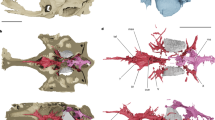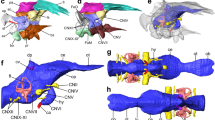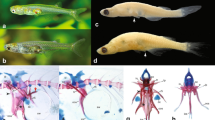Abstract
Most living vertebrates, from teleosts to tetrapods, are osteichthyans (bony fishes)1, but the origin of this major group is poorly understood2. The actinopterygians (ray-finned bony fishes) are the most successful living vertebrates in terms of diversity. They appear in the fossil record in the Late Silurian but are poorly known before the Late Devonian. Here we report the discovery of the oldest and most primitive actinopterygian-like osteichthyan braincase known, from 400–million-year-old limestone in southeastern Australia. This specimen displays previously unknown primitive conditions, in particular, an opening for a cartilaginous eyestalk. It provides an important and unique counterpart to the similarly aged and recently described Psarolepis from China and Vietnam3,4. The contrasting features of these specimens, and the unusual anatomy of the new specimen in particular, provide new insights into anatomical conditions close to the evolutionary radiation of all modern osteichthyan groups.
This is a preview of subscription content, access via your institution
Access options
Subscribe to this journal
Receive 51 print issues and online access
$199.00 per year
only $3.90 per issue
Buy this article
- Purchase on Springer Link
- Instant access to full article PDF
Prices may be subject to local taxes which are calculated during checkout


Similar content being viewed by others
References
Janvier, P. Early Vertebrates. Oxford Monographs on Geology and Geophysics Vol. 33 (Oxford Univ. Press, Oxford, 1996).
Ahlberg, P. E. Something fishy in the family tree. Nature 397, 564–565 (1999).
Yu, X. A new porolepiform-like fish, Psarolepis romeri, gen et sp. nov. (Sarcopterygii, Osteichthyes) from the Lower Devonian of Yunnan, China. J. Vert. Paleontol. 18, 261–274 ( 1998).
Zhu, M. Yu, X. & Janvier, P. A primitive fossil fish sheds light on the origin of bony fishes. Nature 397, 607–610 ( 1999).
Basden, A. M., Hocking, M., Parkes, R., Burrow, C J. & Young, G. C. Siluro–Devonian microvertebrates from southeastern Australia. Cour. Forsch. Senck. (in the press).
Patterson, C. The braincase of pholidophorid and leptolepid fishes, with a review of the actinopterygian braincase. Phil. Trans. R. Soc. Lond. B 269, 275–579 (1975).
Gardiner, B. G. & Bartram, A. W. H. in Problems in Vertebrate Evolution (eds Andrews, S. M., Miles, R. S. & Walker, A. D.) 227– 245 (Academic, London, 1977).
Schultze, H.-P. Palaeoniscoidea-Schuppen aus dem Unterdevon Australiens and Kanadas und aus dem Mittledevon Spitsbergens. Bull. Brit. Mus. Nat. Hist. (Geol) 16, 343–368 ( 1968).
Gardiner, B. G. The relationships of the palaeoniscid fishes, a review based on new specimens of Mimia and Moythomasia from the Upper Devonian of Western Australia. Bull. Brit. Mus. Nat. Hist. (Geol.) 37, 173–428 (1984).
Young, G. C. New information on the structure and relationships of Buchanosteus (Placodermi: Euarthrodira) from the Early Devonian of New South Wales. Zool. Jour. Linn. Soc. 66, 307–352 (1979).
Young, G. C. A new early Devonian placoderm from New south Wales, Australia, with a discussion of placoderm phylogeny. Palaeontographica 167A, 10–76 (1980).
Young, G. C. The relationships of placoderm fishes. Zool. Jour. Linn. Soc. 88, 1–57 (1986).
Goujet, D. Placoderm interrelationships: a new interpretation, with a short review of placoderm classification. Proc. Linn. Soc. NSW 107, 211–243 (1984).
Goujet, D. Les affinités des Placoderms, une revue des hypothèses actuelles. Géobios, Mém. Spéc. 6, 27–38 (1982).
Gardiner, B. G. The relationships of placoderms. J. Vert. Paleont. 4, 379–395 (1984).
Gross, W. Das Kopfskelett von Cladodus wildungensis Jaekel. Senckenbergiana 19, 80–107 ( 1937).
Schaeffer, B. & Dalquest, W. W. A palaeonisciform braincase from the Permian of Texas, with comments on cranial fissures and the posterior myodome. Am. Mus. Novit. 2658, 1– 15 (1937).
de Beer, G. R. The Development of the Vertebrate Skull (Oxford Univ. Press, Oxford, 1937).
Coates, M. I. & Sequeira, S. E. K. The braincase of a primitive shark. Trans. R. Soc. Edinb., Earth Sci. 89, 63–85 (1998).
Miles, R. S. in Interrelationships of Fishes (eds Greenwood, P. H., Miles, R. S. & Patterson, C.) Zool. J. Linn. Soc. 53 (suppl. 1), 63–103 (1973).
Chang, M. M. The braincase of Youngolepis, a Lower Devonian crossopterygian from Yunnan, south-western China. Thesis, Univ. Stockholm ( 1982).
Swofford, D. L. PAUP: phylogenetic analysis using parsimony, version 3.1.1. (Illinois Natural History Survey, Champaigne, Illinois, 1993).
Acknowledgements
We thank D. Goujet and C. Poplin for helpful discussion. A.B. thanks the Australian Museum for use of facilities, and acknowledges support from an Australian Postgraduate Award and Macquarie University Postgraduate Fund. M.I.C. acknowledges support from the Biotechnology and Biological Sciences Research Council UK.
Author information
Authors and Affiliations
Corresponding author
Rights and permissions
About this article
Cite this article
Basden, A., Young, G., Coates, M. et al. The most primitive osteichthyan braincase?. Nature 403, 185–188 (2000). https://doi.org/10.1038/35003183
Received:
Accepted:
Issue Date:
DOI: https://doi.org/10.1038/35003183
This article is cited by
-
A new stem sarcopterygian illuminates patterns of character evolution in early bony fishes
Nature Communications (2017)
-
The origin and early phylogenetic history of jawed vertebrates
Nature (2015)
-
Acanthodes and shark-like conditions in the last common ancestor of modern gnathostomes
Nature (2012)
-
Cranial morphology of the Silurian sarcopterygian Guiyu oneiros (Gnathostomata: Osteichthyes)
Science China Earth Sciences (2010)
-
The oldest articulated osteichthyan reveals mosaic gnathostome characters
Nature (2009)
Comments
By submitting a comment you agree to abide by our Terms and Community Guidelines. If you find something abusive or that does not comply with our terms or guidelines please flag it as inappropriate.




